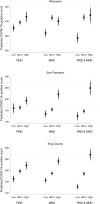Neighborhood socioeconomic inequality based on everyday mobility predicts COVID-19 infection in San Francisco, Seattle, and Wisconsin
- PMID: 35179963
- PMCID: PMC8856620
- DOI: 10.1126/sciadv.abl3825
Neighborhood socioeconomic inequality based on everyday mobility predicts COVID-19 infection in San Francisco, Seattle, and Wisconsin
Abstract
Race and class disparities in COVID-19 cases are well documented, but pathways of possible transmission by neighborhood inequality are not. This study uses administrative data on COVID-19 cases for roughly 2000 census tracts in Wisconsin, Seattle/King County, and San Francisco to analyze how neighborhood socioeconomic (dis)advantage predicts cumulative caseloads through February 2021. Unlike past research, we measure a neighborhood's disadvantage level using both its residents' demographics and the demographics of neighborhoods its residents visit and are visited by, leveraging daily mobility data from 45 million mobile devices. In all three jurisdictions, we find sizable disparities in COVID-19 caseloads. Disadvantage in a neighborhood's mobility network has greater impact than its residents' socioeconomic characteristics. We also find disparities by neighborhood racial/ethnic composition, which can be explained, in part, by residential and mobility-based disadvantage. Neighborhood conditions measured before a pandemic offer substantial predictive power for subsequent incidence, with mobility-based disadvantage playing an important role.
Figures





Similar articles
-
Environmental inequality in the neighborhood networks of urban mobility in US cities.Proc Natl Acad Sci U S A. 2022 Apr 26;119(17):e2117776119. doi: 10.1073/pnas.2117776119. Epub 2022 Apr 21. Proc Natl Acad Sci U S A. 2022. PMID: 35446711 Free PMC article.
-
The health implications of neighborhood networks based on daily mobility in US cities.Soc Sci Med. 2024 Aug;354:117058. doi: 10.1016/j.socscimed.2024.117058. Epub 2024 Jun 24. Soc Sci Med. 2024. PMID: 38943778
-
Wealth, Race, and Place: How Neighborhood (Dis)advantage From Emerging to Middle Adulthood Affects Wealth Inequality and the Racial Wealth Gap.Demography. 2022 Feb 1;59(1):293-320. doi: 10.1215/00703370-9710284. Demography. 2022. PMID: 35040475
-
Neighborhood Disadvantage, Residential Segregation, and Beyond-Lessons for Studying Structural Racism and Health.J Racial Ethn Health Disparities. 2018 Apr;5(2):357-365. doi: 10.1007/s40615-017-0378-5. Epub 2017 Jun 1. J Racial Ethn Health Disparities. 2018. PMID: 28573643 Review.
-
“Not What It Was Made Out”: Hygiene, Health, and Moral Welfare in the Old Nichol, 1880–1900.In: Maltz D, editor. Critical Essays on Arthur Morrison and the East End. Abingdon (UK): Routledge; 2022 Jul 26. Chapter 5. In: Maltz D, editor. Critical Essays on Arthur Morrison and the East End. Abingdon (UK): Routledge; 2022 Jul 26. Chapter 5. PMID: 37590789 Free Books & Documents. Review.
Cited by
-
Socioeconomic reorganization of communication and mobility networks in response to external shocks.Proc Natl Acad Sci U S A. 2023 Dec 12;120(50):e2305285120. doi: 10.1073/pnas.2305285120. Epub 2023 Dec 7. Proc Natl Acad Sci U S A. 2023. PMID: 38060564 Free PMC article.
-
Epidemiological methods in transition: Minimizing biases in classical and digital approaches.PLOS Digit Health. 2025 Jan 13;4(1):e0000670. doi: 10.1371/journal.pdig.0000670. eCollection 2025 Jan. PLOS Digit Health. 2025. PMID: 39804936 Free PMC article. Review.
-
The movement of class: on occupation and everyday mobility patterns in the United States.Front Sociol. 2025 Apr 10;10:1492785. doi: 10.3389/fsoc.2025.1492785. eCollection 2025. Front Sociol. 2025. PMID: 40276371 Free PMC article.
-
Supplemental Nutrition Assistance Program Education reductions during COVID-19 may have exacerbated health inequities.SSM Popul Health. 2023 Jul 23;23:101471. doi: 10.1016/j.ssmph.2023.101471. eCollection 2023 Sep. SSM Popul Health. 2023. PMID: 37560088 Free PMC article.
-
An epidemiological modeling framework to inform institutional-level response to infectious disease outbreaks: a Covid-19 case study.Sci Rep. 2024 Mar 27;14(1):7221. doi: 10.1038/s41598-024-57488-y. Sci Rep. 2024. PMID: 38538693 Free PMC article.
References
-
- Link B. G., Phelan J., Social conditions as fundamental causes of disease. J. Health Soc. Behav. 35, 80 (1995). - PubMed
-
- I. Kawachi, L. F. Berkman, Neighborhoods and Health (Oxford Univ. Press, 2003).
LinkOut - more resources
Full Text Sources
Miscellaneous

